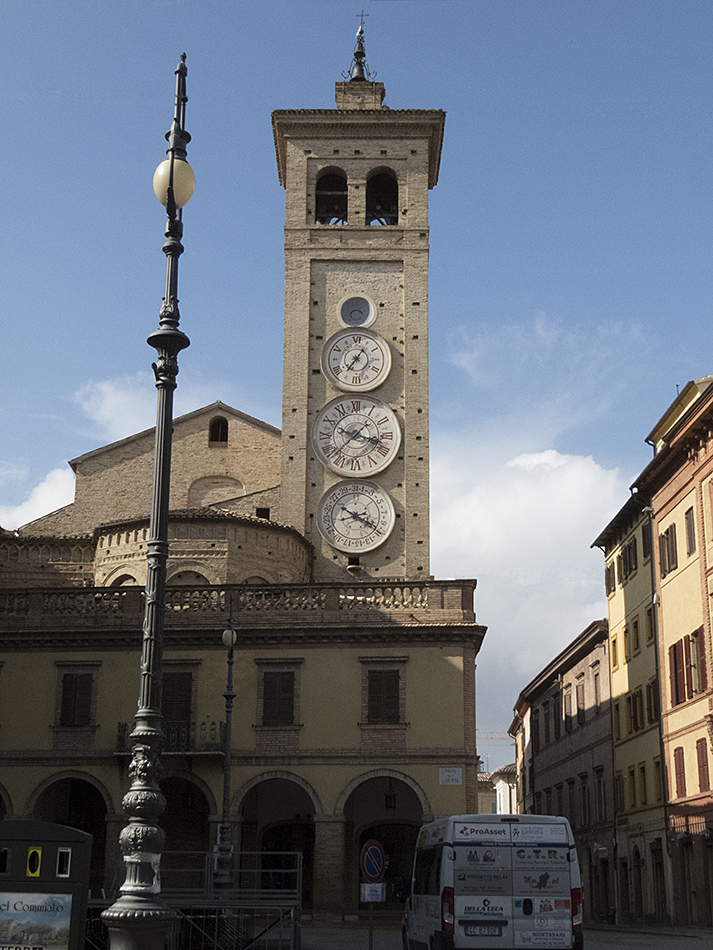
Although time and its measurement is a fundamental component of human life, a special type of clock which takes matters to the next level is the so-called
astronomical clock and whose purpose is not to measure time per se but to convey astronomical information and, in particular, the relative position of the
Sun and Moon as well as the zodiacal constellations and, in some cases, the position of the planets all as a function of time.
The oldest such effort to effectively emulate the overhead celestial sphere (ie a mini-planetarium) is the
Antikythera Mechanism which was discovered in 1901 totally by
accident by sponge divers off the coast of the Greek island of Antikythera. It has been dated to approximately 80 BC and it is believed to be the work of
Poseidonius of Rhodes. The Antikythera Mechanism is currently on display
at the National Archaeological Museum in Athens, Greece.
Note: Tolentino is a small town with a population of only 19,000 inhabitants. It lies 40 km to the west of the Adriatic coast in
central Italy. The primary square, Piazza della Liberta (Liberty Square), hosts a somewhat unorthodox clock tower built in 1822 and which serves as the belfry
to the nearby Church of Saint Francesco. The tower (Torre degli Orologi) is characterized with four separate dials in a vertical format with the first
describing the phase of the moon, the second documenting the time of day using a six-hour dial (aka "Roman clock" and "Italian clock" which was associated with
the Catholic Church and is related to prayer times), the third provides the time of day (hours and minutes) whereas the fourth and final dial provdes the day of
the week and month. Of particular interest is the sundial immediately below the fourth dial which allows the timekeeper to adjust the clock (third dial) to
local solar time.
With respect to the second dial depicting a six-hr dial, the example at Tolentino includes the text "Ave Maria" that refers to the evening prayer which
occurs just after sunset and is considered the start of each day with the following 24 hours split into four segments (and rotations of the clock) of six hours
each. The six--hour clock was in effect throughout Italy into the late 18th century with many examples still available throughout Italy including the Vatican.
The third dial depicting the time of day is comprised of two rings labelled with the roman numerals I through XII for the outer ring and the arabic numerals
13 through 24 for the inner ring, thus accounting for the first half and second half of each day respectively. As noted above, a sundial below the fourth and
final dial allows the horologist to adjust the clock to local solar time, thus making the Torre degli Orologi quite unique.
The fourth and final dial has an outer ring labelled with the arabic numerals I through 31 and is used to denote the day of the month whereas an inner ring
includes the letters "D" (12 o'clock position) and followed by the letters "L", "M", "M", "G", "V" and "S" (clockwise fashion) which represent "Domenica"
(Sunday), "Lunedi" (Monday"), "Martedi" (Tuesday), "Mercoledi" (Wednesday), "Giovedi" (Thursday), "Venerdi" (Friday) and "Sabato" (Saturday) respectively.
Note: For a view of the astronomical clock and its individual dials using greater focal length, please click
here,
here,
here and
here.
Note: For additional results involving astronomical clocks from around the world, please click
here.
|
Body: Sun Mass: 332,900 x Earth Mass Eq Diameter: 109.1 x Earth Distance: 149 million km RA / Dec: 23h 41m 41s / +89° 19' 51" Diameter: 32.16' Magnitude: -26.8 |
 |
Date: Sept 15, 2023 Location: Piazza della Liberta, Tolentino, Italy Equipment: Canon PowerShot SX60 HS @ 23.38 mm / f8.0 Exposure: 1 x 1/1000 sec ISO 400 RAW Image Format 4768x3516 Image Size Continuous Servo Mode Manual Mode Software: Photoshop CS6 Processing: Brightness/Contrast Resampling JPG Compression |